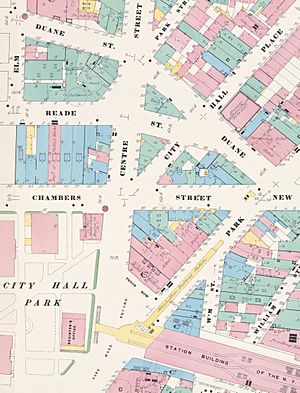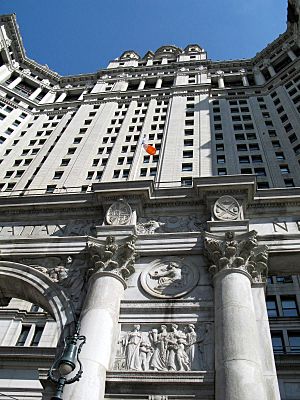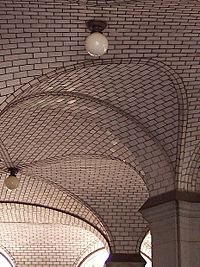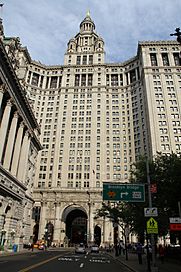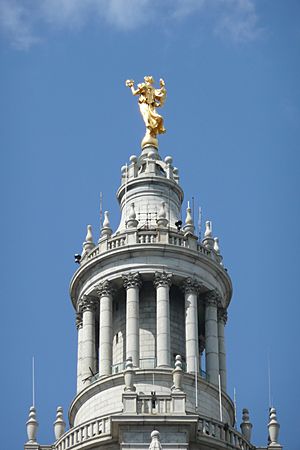Manhattan Municipal Building facts for kids
|
Manhattan Municipal Building
|
|
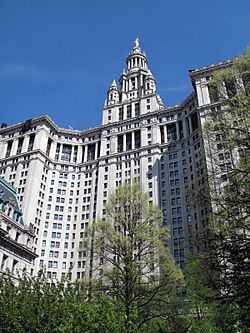 |
|
| Location | Manhattan, New York |
|---|---|
| Built | 1909–1914 |
| Architect | William M. Kendall |
| Architectural style | Ancient Roman Beaux-Arts French Renaissance Renaissance |
| NRHP reference No. | 72000879 |
Quick facts for kids Significant dates |
|
| Added to NRHP | October 18, 1972 |
The David N. Dinkins Municipal Building (originally the Municipal Building and later known as the Manhattan Municipal Building) is a 40-story, 580-foot (180 m) building at 1 Centre Street in Manhattan, near Centre Street's intersection with Chambers Street in New York City. The structure was built to accommodate increased governmental space demands after the 1898 consolidation of the city's five boroughs. Construction began in 1909 and continued through 1914 at a total cost of $12 million (equivalent to $243,132,000 in 2021).
Designed by McKim, Mead & White, the Manhattan Municipal Building was among the last buildings erected as part of the City Beautiful movement in New York. Its architectural style has been characterized as Roman Imperial, Italian Renaissance, French Renaissance, or Beaux-Arts. The Municipal Building is one of the largest governmental buildings in the world, with about 1 million square feet (93,000 m2) of office space. The base incorporates a subway station, while the top includes the gilded Civic Fame statue.
The Municipal Building was erected after three previous competitions to build a single municipal building for New York City's government had failed. In 1907, the city's Commissioner of Bridges held a competition to design the building in conjunction with a subway and trolley terminal at the Brooklyn Bridge, of which McKim, Mead & White's plan was selected. The first offices in the Municipal Building were occupied by 1913. In later years, it received several renovations, including elevator replacements in the 1930s and restorations in the mid-1970s and the late 1980s. The New York City Landmarks Preservation Commission designated the building a landmark in 1966, and it was listed on the National Register of Historic Places in 1972.
Contents
Site
The Manhattan Municipal Building is located on the eastern side of Centre Street, in the Civic Center of Manhattan. It occupies the length of two city blocks, between Duane Street to the north and the Brooklyn Bridge ramps to the south; the west–east Chambers Street has its eastern terminus at Centre Street, at the center of the building's base. Near the Municipal Building are the Thurgood Marshall United States Courthouse and St. Andrew Church to the northeast; 1 Police Plaza and the Metropolitan Correctional Center to the east; Surrogate's Courthouse and Tweed Courthouse to the west; and New York City Hall to the southwest.
Prior to the Municipal Building's construction, several streets passed through the building site, which had been located at the south end of the Five Points neighborhood. New Chambers Street continued east through the center of the building, while the west-east Reade Street continued eastward through what is now the building's northern edge. City Hall Place (now Cardinal Hayes Place) originated at the intersection of Chambers and Centre Streets, crossing southwest–northeast through the building site. The area to the south of the Municipal Building was once known as Tryon Row, a one-block east–west street between Centre Street and Park Row. The Municipal Building's site was occupied by buildings including the old headquarters of the New Yorker Staats-Zeitung. Immediately to the south were two elevated railway stations: the Park Row Terminal of the Brooklyn Rapid Transit Company (closed 1944) and the City Hall station of the Interborough Rapid Transit Company (closed 1953).
After the Municipal Building was finished, New Chambers Street ran through the building's central archway. Park Row bounded the building to the southeast and Duane Street abutted it to the northeast. Park Row was rerouted in the mid-20th century, and New Chambers and Duane Streets were closed in 1971 as part of 1 Police Plaza's construction. The Streets subsequently became part of a pedestrian plaza surrounding the Municipal Building and 1 Police Plaza.
Design
The Municipal Building is 559 feet (170 m) tall. It is one of the largest governmental buildings in the world, with about 1 million square feet (93,000 m2) of interior space and 2,000 employees. Of this, about 600,000 square feet (56,000 m2) is used for offices.
William M. Kendall of the architectural firm McKim, Mead & White designed the Municipal Building. Two of the firm's other partners, Burt L. Fenner and Teunis J. van der Bent, were tasked with leading construction, while the city's Department of Bridges supervised the project. Alexander Johnson was chief engineer, Purdy and Henderson were consulting engineers, and the Thompson–Starrett Company was the general contractor. The Mount Waldo Construction Company provided the granite, while Robert Wetherill & Co. installed the original elevators. The foundations were dug by the Foundation Company.
Enormously influential in the civic construction of other American cities, the building's architectural style has been "variously described as Roman Imperial, Italian Renaissance, French Renaissance, or Beaux-Arts." Its construction marked the end of the City Beautiful movement in New York. The Municipal Building was the first of several ornately-designed civic office buildings, influencing other structures such as the Terminal Tower in Cleveland, the Fisher Building in Detroit, the Wrigley Building in Chicago, and the Helmsley Building in Midtown Manhattan.
Form
The building is shaped like a ten-sided "C", although the lot that it occupies is an irregular hexagon. The main facade, along Centre Street to the west, is 381 feet (116 m) long while the eastern facade is 168 feet (51 m) long. The building has a width of 168.5 feet (51.4 m), measured from west to east. The northeastern and southeastern sides accommodated the diagonal paths of Duane Street and Park Row, respectively. The floors' north–south axes are longer than their west–east axes; the wings of the "C" face west. This floor plan ensured that all of the building's windows would be able to receive direct sunlight and eliminated the need for an interior courtyard, which could not be lit by sunlight.
The Manhattan Municipal Building is 34 stories tall; the main structure consists of 26 stories, and a tower rises eight additional stories above the center of the structure. The main cornice is 349 feet (106 m) above ground level while the tower rises to 560 feet (170 m) above ground level. Including the Civic Fame statue, the building stands at either 580 feet (180 m) or 582 feet (177 m). Atop the northern and southern wings of the "C" are pavilion roofs, which are connected to the central tower with roof decks and a stone cornice. The central tower is composed of a two-story square section; atop this is a circular section flanked by four circular turrets above each corner of the square. The circular section of the central tower is composed of two layers: an enclosed space surrounded by columns, atop which is a smaller peristyle.
The Municipal Building was the first in New York City to incorporate a subway station, the Chambers Street station, below its base. The approved building plans in 1909 also called for three basement levels within the volume not occupied by the subway station.
Facade
The building consists of 25 bays on its western and eastern facades (counting the eastern facade as being composed of the northeastern, southeastern and eastern elevations) and three bays on its northern and southern facades. Each bay contains either one or two windows on each story. The facade is made of ashlar granite, except for the details above the 23rd floor, which are made of terracotta. A three-story-tall colonnade of Corinthian columns runs across the base along Centre Street, with the rest of the building set back behind the colonnade. At the top of the colonnade is a carved entablature. There is also a false colonnade on the facade above the 22nd floor. The 1939 WPA Guide to New York City stated that the facade "gains dignity through the bold treatment of the intermediate stories, despite the poorly related tower and the disturbing character of the Corinthian colonnade at the base".
Features
Base
A large arched vault is located at the center of the building's base, at the eastern end of Chambers Street, and is flanked by two smaller arched vaults. It is designed in the neoclassical style like the Arch of Constantine. The vault was large enough to accommodate New Chambers Street, which was closed in 1971 to make way for a pedestrian plaza in front of One Police Plaza and the Manhattan Municipal Building. The terracotta vault was modeled on the entrance of the Palazzo Farnese in Rome, and was also called the "Gate of the City" after William Jean Beauley painted an image of the scene. The vault separates the lobby into two sections, each with its own set of elevator banks. The second through fifth stories are also divided into two portions by the vault.
As constructed, the first floor was devoted entirely to public space, with two open loggias and the two portions of the lobby. The loggia under the southern wing still exists, with staircases leading to the subway from both the north and south. It is supported by a set of columns and has a ceiling of white Guastavino tiles. The loggia under the northern wing is no longer extant, having been enclosed.
The Chambers Street subway station, served by the J and Z train, consists of two levels below the building: the mezzanine (shared with the Brooklyn Bridge–City Hall station, served by the 4 5 6 <6> trains) and the platform level. The station opened in 1913, and was intended as the Brooklyn Rapid Transit Company's main subway terminal in Manhattan, but fell into disrepair after businesses moved uptown in the 1930s. When the Municipal Building was completed, there were also supposed to be new station buildings for the adjacent elevated IRT and BRT stations, designed in the same architectural style. The tracks from the Chambers Street station would have also connected directly to the elevated tracks on the Brooklyn Bridge, but the connection was never opened.
Structural features
While the layer of bedrock under the Municipal Building was quite close to the surface underneath the southern part of the building, the bedrock dropped to a depth of about 180 feet (55 m) under the northern portion of the site, where it would be extremely difficult to dig caissons. A layer of sand was present to a depth of 130 feet (40 m), while the average depth of the bedrock under the building was about 144 feet (44 m). The contract for the foundations was the largest to be awarded for a single building in the United States, with 140,000 cubic yards (110,000 m3) being excavated at a cost of $1.5 million. The foundations incorporated 50,000 cubic yards (38,000 m3) of concrete for the piers, as well as 70,000 barrels of cement. The foundations also included 125 caissons extending to an average depth of 130 feet (40 m). The maximum depth of the caissons was 145 feet (44 m) below grade, and for the northern part of the site, the Foundation Company built larger caissons resting on sand at a depth of 74 feet (23 m). While the caissons under the southern two-thirds of the building carry 15 short tons per square foot (150 t/m2), the larger caissons under the northern third of the building carry only 6 short tons per square foot (59 t/m2).
The Municipal Building's frame had 26,000 short tons (23,000 long tons; 24,000 t) of steel, which required 20 derricks to erect. The superstructure weighed a total of 180,000 short tons (160,000 long tons; 160,000 t). The above-ground walls, and half of the beams in the superstructure, were carried by steel-plate girders at the first floor. The girders were connected to other steel beams, which distributed the building's entire weight to the caissons. Each of the first-floor girders were about 10 feet (3.0 m) deep and grouped in sets of two or three. The Municipal Building's largest girders, supporting the Chambers Street arch, were 36 feet (11 m) long and up to 11 feet (3.4 m) deep.
Interior
The floors were arranged so that the elevator banks and stairs were on the eastern side of the building, while the offices were concentrated along the western side and on the north and south wings. There were four staircase shafts that extended the height of the building. In addition, 33 elevators were provided in the initial construction, though this number was later expanded to 37. Of the original elevators, 32 were accessible from the lobby. Most of the elevators from the lobby traveled only to the 25th story, where a separate elevator connected the 25th through 37th floors. During the 1934 elevator replacements, eight of the elevator shafts were shortened to make way for office space. Because the basement is mostly taken up by the subway station, the mechanical equipment is located on the fourth floor. The elevators were controlled by a dispatching room on the 26th floor.
A typical story had 27,000 square feet (2,500 m2) of net office space. The materials in the Municipal Building included 400,000 square feet (37,000 m2) of hollow-tile partitions, 500,000 square feet (46,000 m2) of cement flooring, 60,000 square feet (5,600 m2) of asphalt flooring in the vaults, 340,000 square feet (32,000 m2) of plastering, and 160,000 square feet (15,000 m2) of Yule marble. Other types of marble, such as Tennessee marble, were used for decorative elements such as the baseboards of the rooms. Steel was painted to resemble wood, while wooden elements were only used for door and window frames. Most of the floors are made of cement, but the fifth floor, originally used for public hearings and the municipal reference library, had 34,000 square feet (3,200 m2) of cork flooring to reduce noise.
History
Previous plans
By the late 19th century, New York City governmental functions had outgrown New York City Hall. At the time, the city government's agencies rented space in various buildings from Downtown Manhattan up to Midtown Manhattan, with the number of such arrangements increasing by the year. In the 1884 annual report of the City of New York, mayor Franklin Edson declared that more space was urgently needed for governmental functions. He also noted that City Hall's "style of architecture was such that without marring its present symmetry, it couldn't be enlarged to the required extent." Edson suggested buying 280 Broadway, at the corner with Chambers Street, for use by the city government.
The government, desiring to cut down the amount of rent paid to private landlords, ultimately held four design competitions for a new, massive building that would be suitable to house many agencies under one roof. As early as 1885, a commission was empowered to look for plots of land where such a structure could be built, and by 1887, authorities were considering erecting a structure adjacent to City Hall itself, in City Hall Park. Mayor Abram Hewitt appointed a commission to study suitable plans and plots of land in 1888, although Hewitt opposed putting such a building anywhere except City Hall Park. The commissioners of the Sinking Fund initially approved a municipal building east of the Tweed Courthouse, at the park's northeastern corner. An architectural design competition was commenced for this new building, and seven architects submitted plans. Charles B. Atwood's winning proposal called for a pair of seven-story pavilions flanking City Hall. The public generally opposed the idea of development in the park, and the plan was voted down by the New York State Senate in February 1890.
The law authorizing the new building was modified in 1890 so that the new structure would be able to house other city agencies as well. Mayor Hugh J. Grant proposed a large municipal office building in early 1890, and that July, a committee of the city government was created to look for alternate sites. The committee published a report in October 1890, outlining three possible sites on Chambers Street. The first option was southwest of Chambers Street and Broadway; the second, northwest of Chambers and Centre Streets; and the third, northeast of Chambers and Centre Streets (at the current building's location). The committee recommended the third option, which would be the cheapest and offer the most floor area, as well as provide an opportunity for redevelopment at that location. However, the city government decided in March 1893 that the municipal building would instead replace City Hall, with two wings extending north to flank the Tweed Courthouse, despite the committee's recommendation and public objections to a City Hall site. The committee ultimately received 134 plans for such a new building, with six of these being selected as finalists. In response to opposition to City Hall's demolition, the New York governor signed a law in 1894 that once again prohibited the municipal building's construction. The six finalist submissions were supposed to receive monetary prizes, but ran into difficulty even collecting their awards, since the city had never formally accepted the committee's report on the finalists.
In 1899, architect George B. Post proposed a municipal office tower to be built at the northeast corner of Chambers and Centre Streets, while preserving City Hall, as part of a greater plan to rearrange Lower Manhattan's streets. The next March, state senator Patrick H. McCarren proposed a bill that would construct the municipal building on the blocks bounded by Broadway and Reade, Centre, and Chambers Streets, north of the Tweed Courthouse and west of the current building's site. The structure would replace 280 Broadway and the old Emigrant Industrial Savings Bank Building, incorporate the then-under-construction Hall of Records, and would also entail destroying the Tweed Courthouse. Several architects submitted proposals, the most elaborate of which was by McKim, Mead & White. Additionally, in 1903, the city's bridge commissioner Gustav Lindenthal hired George Post and Henry Hornbostel l as architects for a planned trolley hub at the foot of the Brooklyn Bridge, just east of City Hall. This plan also involved constructing a 45-story municipal office tower with a campanile at Chambers and Centre Streets. The municipal building and trolley hub plans were deferred by the administration of mayor Seth Low when he left office at the end of 1903.
Planning and construction
Planning
By early 1907, the Hall of Records had been completed, but there was still not enough space for the city's important files; further, the city was paying large amounts for rent in private buildings. Officials pointed out that the cramped quarters of the city government's departments posed a fire hazard, and legislation had been proposed for a new municipal building. In July 1907, Lindenthal—who had already secured a new plot of land for the Brooklyn Bridge trolley hub—was authorized by the state legislature to host a fourth and final design competition for the municipal building. The Brooklyn loop line, a four-track subway line, was planned to be built under the site as well, passing through a large five-platform station at Chambers Street.
Thirteen architects were invited to compete, and they would in turn elect a jury of three architects, whose names would not be published in advance. The Commissioner of Bridges would make a final decision based on the jury's recommendation. The plans had to meet several criteria: the building had to be at least 20 stories; the superstructure could not block train tracks, stairways, or platforms; the route of Chambers Street under the building had to be preserved; and the first floor, to be used for transit and building entrances, had to be completely covered, with a ceiling of at least 20 feet (6.1 m). The commissioner also recommended that the first story of each level be at ground level, and that an above-ground level be provided for mechanical equipment and building systems. The contestants were otherwise given "considerable freedom" for the building's design. By December 1907, several architects had submitted plans.
Twelve architectural firms ultimately entered the competition, while Cass Gilbert withdrew. The jury selected McKim, Mead & White's proposal as the winning entry in April 1908. The firm's design had been chosen because it provided the most space for the city government, even though it was less elaborate than some of the other submissions, such as the runner-up proposal by Howells & Stokes, inspired by 90 West Street. McKim, Mead & White had entered the contest under the encouragement of mayor George B. McClellan Jr., and William Mitchell Kendall was the principal architect named in the submission. The firm submitted plans for a 559-foot-tall (170 m) building to the New York City Department of Buildings in October 1908. The city had initially intended to erect the Manhattan Municipal Building on a plot immediately to the south of the current site, bounded by Park Row, the Brooklyn Bridge, and North William Street. The accepted plan, however, called for the building to be located between Park Row, Centre Street, and Duane Street, with Chambers Street running under the Municipal Building's center.
Construction
By late 1908, the site was being cleared. Bids for foundation work were opened in December 1908, with the contract being awarded to the J. H. Gray Company. However, the original building plans were rejected by the city's buildings superintendent the same month because he felt that the underlying layer of soil and sand was not strong enough to carry the building. This resulted in delays in the construction of the proposed Brooklyn loop line under the building. Ultimately, the Foundation Company was contracted to dig the foundation with caissons under a very high air pressure of 47 pounds per square inch (320 kPa). Work was done in 20 shifts of five men working for forty minutes each day; only two workers developed decompression sickness and neither of them died. In a January 1909 speech, McClellan praised the project as "one of the most important projects the City has ever undertaken". At the time, he predicted that the building would cost $8 million.
Work on the Municipal Building officially started on July 17, 1909. One observer predicted that the building's construction would result in an increase in real-estate values, similar to what the Flatiron Building had done for the Flatiron District. Foundation work was completed in October 1909, and revised building plans were approved by the Board of Estimate that November. Bids for the construction of the superstructure were opened on December 21, but an injunction against the awarding of the contract was placed less than an hour after the bidding process started, after a lawsuit was filed over the fireproofing material that was supposed to be used in the building. Furthermore, the presence of the sand posed issues for the superstructure, though McClellan said that he believed it was safe to build on sand. The building's 4-short-ton (3.6-long-ton; 3.6 t) cornerstone was laid a week later, and the injunction was reversed. Unlike at other projects, the groundbreaking ceremony was private, and the cornerstone only had the year "1907" inscribed in Roman numerals.
During construction in 1911, a fire broke out on the 25th floor; at the time, it was the highest fire to date that the New York City Fire Department had fought. In another construction incident, three workers were buried when temporary bracing in the foundation collapsed, though all survived. Steel frame construction took place between June 1910 and July 1911, followed by the installation of exterior walls between March 1911 and November 1912. There were delays in installing the granite facade because the original materials were found to be inferior. By 1913, the superstructure was topped out with the unveiling of Civic Pride at the top of the Municipal Building's tower.
Use
1910s and 1920s
The first sections of the Municipal Building were occupied in mid-1913. The building had not been ready at the beginning of the year, forcing some city departments to renew the leases at their existing quarters. Mayor John Purroy Mitchel, after taking office in 1914, criticized the usage of space in the Municipal Building as "wasteful". Some of the city departments that were scheduled to move into the building had found space elsewhere, and other city departments had been allotted less space in the building than in their previous quarters. Two years later, the New York City Board of Estimate commenced an investigation into office vacancies at the Municipal Building, after the New York Public Service Commission leased floors in other buildings.
The building had cost $12 million (equivalent to $243,132,000 in 2021), which was not repaid with interest until 1964; the interest was more than twice the original cost. The land alone had cost $6 million. Nevertheless, the structure was expected to save the city from paying $800,000 a year in rent. Upon opening, the Municipal Building housed 4,200 city employees. It was patrolled by a private police force, which monitored the building 24 hours a day, as well as a cleaning crew of 135 people. There were also telephone switchboards for inter-departmental communication, which at the time of completion were described as state-of-the-art. A nonprofit organization established a cafeteria on the 26th floor in 1918; although the city provided no subsidies to the cafeteria, the cafeteria also did not have to pay rent. Radio station WNYC (AM) started broadcasting from the 24th floor in 1924, remaining there for 85 years, and a small hospital was established on the third floor in 1929. The Municipal Building's size notwithstanding, various entities had proposed to build an even larger municipal skyscraper to the west by the 1930s, but with no success.
1930s to 1950s
By 1934, Manhattan borough president Samuel Levy called the elevators "unsafe", given that all of the elevators needed twice-daily inspections, and their manufacturer had gone out of business soon after installing them. The city had to make its own replacement parts for the elevators, which had been described as "old and wheezy", and acting like "Coney Island roller coasters", and fourteen of the elevators had to be taken out of service in late 1934. All of the elevators were replaced between 1935 and 1937, under a project funded partially with a $1.8 million grant from the Works Progress Administration. While the elevators were being replaced, city employees in the building worked in three staggered shifts. The elevator project also shortened several elevator shafts: within the north and south wings, some of the shafts above the 14th floor were removed to make way for office space. Civic Fame at the top of the Municipal Building was also refurbished during the 1930s, and green mercury vapor bulbs were also installed in the north lobby.
By 1939, the building could not accommodate all of the city government's agencies, several of which were located in alternate quarters surrounding Foley Square to the north. The offices in the Municipal Building included radio station WNYC on the 25th floor, the Municipal Reference Library on the 22nd floor, and the Marriage Chapel on the 2nd floor. In 1949, the city's commissioner of public works announced that four floors would be renovated and modernized in the first phase of a planned multi-stage overhaul. The next year, the city began installing a dial-telephone system at the Municipal Building, replacing the fourteen old telephone switchboards. At the time, the 20 city agencies in the building had a collective 1,264 telephones. The new switchboards were activated in 1951, and every line in the Municipal Building was given the same 10-digit phone number with 1,426 four-digit extensions.
1960s to present
The New York City Landmarks Preservation Commission designated the building a landmark in 1966, and it was listed on the National Register of Historic Places in 1972. In 1974, Wank Adams Slavin was hired to undertake a $24 million renovation of the building's interior. As part of the renovation, corridors were narrowed and partitions between offices were removed to create more office space; vinyl floor tiles and recessed lighting were installed; and the outdated plumbing system was replaced. The project increased interior capacity to 6,500 employees. During this time, Civic Fame was also renovated. The building had been cleaned by 1975 at a cost of $300,000, though more funds for the renovation had also been appropriated.
A piece of granite fell from the Municipal Building in 1987, landing on a ramp on the Brooklyn Bridge, although no one was injured. However, a subsequent investigation found other loose rocks on the facade, and as a result, netting was placed on the facade. In 1988, workers began placing scaffolding along the building's entire facade in preparation for the first large-scale restoration of the facade, which was to begin the next year. The renovation was expected to cost $58 million and required 39 miles (63 km) of steel tubes to support the massive scaffolds. The facade restoration was undertaken by the architects Wank Adams Slavin. Another restoration of Civic Fame took place during this time. On October 14, 2015, the building was renamed after David N. Dinkins, New York City's first African-American mayor.
Art
The building features various types of sculpture and relief. These include the large gilded Civic Fame statue at the top of the building; smaller sculptural groups; and plaques and coats-of-arms representing the various governments that have ruled Manhattan.
Civic Fame
At the top of the Municipal Building is Civic Fame, a 25-foot-tall (7.6 m) statue installed in March 1913. The statue is a gilded copper figure, made from about 500 pieces of hammered copper executed by the Manhattan firm of Broschart & Braun. The statue is variously reported to be supported on an iron skeleton and made over a steel frame. Civic Fame has been variously described as the largest or second-largest statue in Manhattan, depending on whether the larger Statue of Liberty is considered as being in Manhattan. It is similar in style to the Statue of Liberty.
The statue was designed by Adolph Alexander Weinman (1870–1952). It was commissioned by New York City at a cost of $9,000 (equivalent to $266,000 in 2022) to celebrate the consolidation of the five boroughs into the City of New York. The figure—described as "graceful and unusually charming"—is barefoot and balances upon a globe. She carries various symbolic items: a shield bearing the New York City coat of arms, a branch of leaves, and a mural crown, which she holds aloft. The mural crown has five crenellations or turrets, which evoke city walls and represent the five boroughs. The crown also includes dolphins as a symbol of "New York's maritime setting". Audrey Munson posed for the figure; she had also posed for a very large number of other important allegorical Beaux-Arts sculptures in New York, including those at the Alexander Hamilton U.S. Custom House, New York Public Library Main Branch, Manhattan Bridge Colonnade, and USS Maine National Monument at Columbus Circle.
The left arm was repaired in 1928 after cracks were detected on that side. After Civic Fame's 150-pound (68 kg) left arm broke off, fell through a skylight, and landed on the 26th-floor cafeteria in February 1935, the statue was renovated, with metal rods being used to hold up the left arm. The sculpture was refurbished and re-gilded starting in July 1974 at a cost of $294,500, as part of the interior renovations of the Municipal Building; the restoration was completed by the end of the year. In early 1991, while the facade was undergoing renovations, Civic Fame was removed for six months and re-gilded in a New Jersey metalwork shop at a cost of $900,000. Civic Fame was placed back on the roof in October 1991 using a helicopter.
Other ornamentation
In addition to Civic Fame, Weinman sculpted the rectangular allegorical bas-relief panels at the base of the building, which are located above the side arches. Civic Duty, above the smaller arch to the right (south) of the center arch, shows a female representation of the city alongside a child holding the city seal. Civic Pride, above the smaller arch to the left (north), depicted the city as a woman "receiving tribute from her citizens". There are heroic-scaled winged figures above the spandrels of the side arches: Guidance, a depiction of a female on the left arch, and Executive Power, a depiction of a male on the right arch. These are respectively topped by medallions representing Progress, a kneeling man with a torch in one hand and a winged sphere in the other, and Prudence, a kneeling woman holding a mirror while a serpent is curled around her right arm.
Shields relating to Manhattan's historical and current governance were also designed for the facade above the ground-story colonnade, 22nd-floor false colonnade, and elevators. The shields represent the historical New Amsterdam and the Province of New York, as well as the present-day county, city, and state of New York (the county of New York being coextensive with the borough of Manhattan).
Agencies
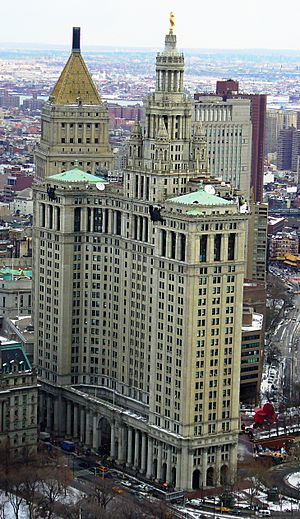
The following New York City public offices are located in the Manhattan Municipal Building:
- New York City Department of Citywide Administrative Services
- New York City Department of Finance
- New York Public Service Commission
- Manhattan Borough President
- New York City Public Advocate
- New York City Comptroller
- New York City Landmarks Preservation Commission
- New York City Office of Payroll Administration
- New York City Tax Commission
- Field offices of the Office of the Mayor, New York City Department of Information Technology and Telecommunications (DoITT), New York City Department of Buildings, New York State Office of the Inspector General, and New York City Department of Environmental Protection.
The Office of the City Clerk was formerly housed in the Municipal Building; about 16,000 weddings were performed annually at the former Manhattan Marriage Bureau in the Municipal Building, in civil ceremonies lasting about four minutes. The City Clerk's Office relocated to nearby 141 Worth Street in 2009.
Images for kids
See also
 In Spanish: Manhattan Municipal Building para niños
In Spanish: Manhattan Municipal Building para niños


